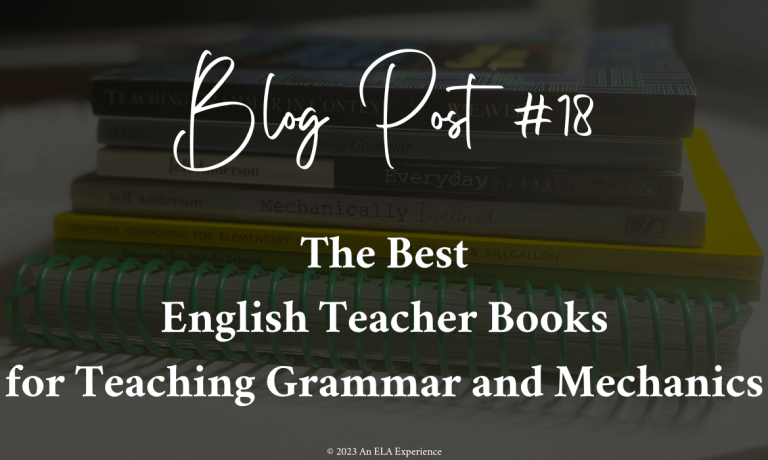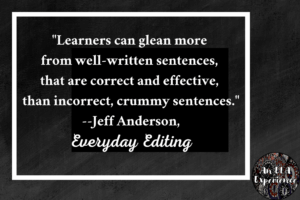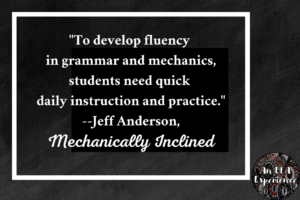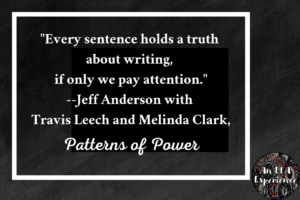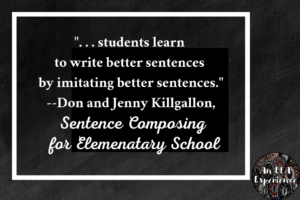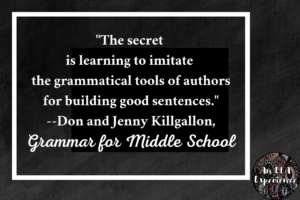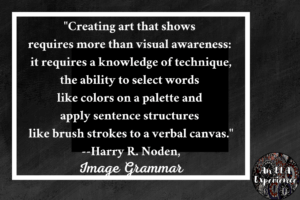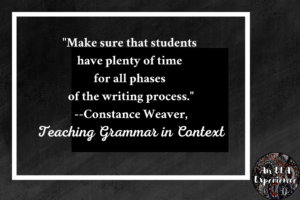Teaching grammar can seem challenging, but reading English teacher books can make it easy and fun for you and your students! A district ELA specialist (my unofficial, self-assigned mentor) blessed me with this knowledge by assigning department coordinators, including me, dozens of books to read (usually one a month, but there was a year some of us read and summarized thirty)!
For our book studies, we read from cover to cover. However, one great thing about reading nonfiction is that you can flip to the index or table of contents for the skill you want to cover, read a few pages, and get some engaging ideas that take your teaching to the next level. When you’re pressed for time, read what you need!
Here are seven of my favorite titles that focus on teaching grammar and mechanics.
Three English Teacher Books by Jeff Anderson

Everyday Editing: Inviting Students to Develop Skill and Craft in Writer’s Workshop
I will read everything Anderson writes because he’s that good. In Everyday Editing, he uses mentor texts with invitations to notice, imitate, celebrate, collect, write, combine, revise, and edit. He then models this process with ten lessons for teaching various topics (e.g., colons, dialogue, apostrophes, paragraphing, capitalization, appositive phrases, compound sentences).
“If I Had a Million Dollars,” the adverb clause lesson in blog post #12, is Anderson’s idea, as is Hairs, the apostrophe lesson in post #17. These two lessons offer only a sampling of the engaging activities Anderson shares.

Mechanically Inclined: Building Grammar, Usage, and Style into Writer’s Workshop
Using a writer’s workshop model, Anderson shares lessons on everything from adjectives to prepositions to verbs. For examples of some of his ideas, see the “Apostrophe-thon” from blog post #17, the describing a room without using prepositional phrases from post #16, and the When-I-Was-Little adverb clause lesson from post #12. These will give you a taste of what you can find in Mechanically Inclined.

Patterns of Power: Inviting Adolescent Writers into the Conventions of Language
When preparing to write this post, I reached out to my English teacher friends, another blessing, and this is one title mentioned that I hadn’t read, so I bought it and started reading, and I’m excited to read more! (You know you’re a grammar nerd when you get a kick out of reading about grammar, and since you’re reading this blog post, I know I’m not alone!)
This book, written with Travis Leech and Melinda Clark, includes over four hundred pages on teaching clauses, phrases, pronouns, sentences, and more. And there is so much that delights me about Patterns of Power (e.g., ideas for clarifying misconceptions, exercises with attention-getting mentor sentences, a soundtrack listing more than fifty songs with suggestions for implementation). There is even a Facebook group for Patterns of Power, and it has over 11,000 members! Wow!
Two English Teacher Books by Don and Jenny Killgallon

Sentence Composing for Elementary School: A Worktext to Build Better Sentences
Even though this book says elementary in the title, I use it with older students. The Killgallons provide exercises with mentor texts for teaching adverb clauses, appositive phrases, participial phrases, etc. (standards seen at upper-grade levels). The mentor sentences are from elementary-level books for the most part, but the concepts work for middle and high school. They focus on matching, chunking, combining, unscrambling, expanding, and imitating to help students learn these various structures from mentor texts. (This book is filled with exercises, so it’s perfect for anyone interested in learning about various sentence constructions.)

Grammar for Middle School: A Sentence-Composing Approach
The exercises in this book are like those in Sentence Composing for Elementary School with combining, expanding, and imitating, for example, but the mentor texts are at a higher reading level (e.g., Bradbury and Tolkien vs. Rylant and Sachar).
When I was teaching, I used this book for daily warm-ups. When I started selling on Teachers Pay Teachers, I used it as a model to create a slideshow of warm-ups where students write one sentence a day (combining, imitating, and composing exercises from mentor texts published before 1923).
An English Teacher Book by Harry R. Noden

Image Grammar: Using Grammatical Structure to Teach Writing
I was introduced to Noden’s book at a five-day workshop where Jeff Anderson was one of the presenters, and it’s because of this workshop that I know how to teach students about topics like dialogue, parallel structure, and participial phrases.
He divides each chapter into concepts and strategies and provides plenty of lessons that can be easily implemented (e.g., his brushstrokes where he shows readers how to add verbs, participles, absolutes, appositives, and adjectives out of order to writings).
An English Teacher Book by Constance Weaver

Teaching Grammar in Context
This is an oldie but goodie. In the first half of the book, Weaver discusses the research on teaching grammar along with the instructional lessons learned from that research. For example, grammar should be taught in context, as the title suggests. (You’ll be happy to know that the titles I’ve shared with you are supported by this research.) The second half of the book includes ideas for grammar instruction.
Related Links for English Teacher Books
For high school resources, check out Jeanmarie’s blog post:
6 Books By English Teachers for English Teachers – McLaughlin Teaches English.
For English teacher books focusing on professional development, visit Melissa’s post:
Best Books for English Teachers: Professional Development – Reading and Writing Haven.
English Teacher Books for Teaching Grammar in a Nutshell
All of these books show teachers how to teach grammar within the context of writing. It’s impossible to recommend just one, so I’ll end with this:
- Use one of the Killgallon books if you’re learning about various sentence structures with your students.
- Choose any of Anderson’s books for engaging lessons your students will LOVE.
- Check out Noden for concepts and strategies on a variety of skills (e.g., punctuation, specific details, parallel structures).
- Read Weaver if you’re interested in research and lessons on teaching grammar.
Choose a book or two and start reading! Devour a few pages before you go to bed or during your students’ silent reading time. Dog-ear favorite pages or take short notes on lessons you want to try (with skills and page numbers for easy reference). Keep track of what you read, even blog posts, for yearly teacher evaluations. There are plenty of benefits to reading English teacher books!

